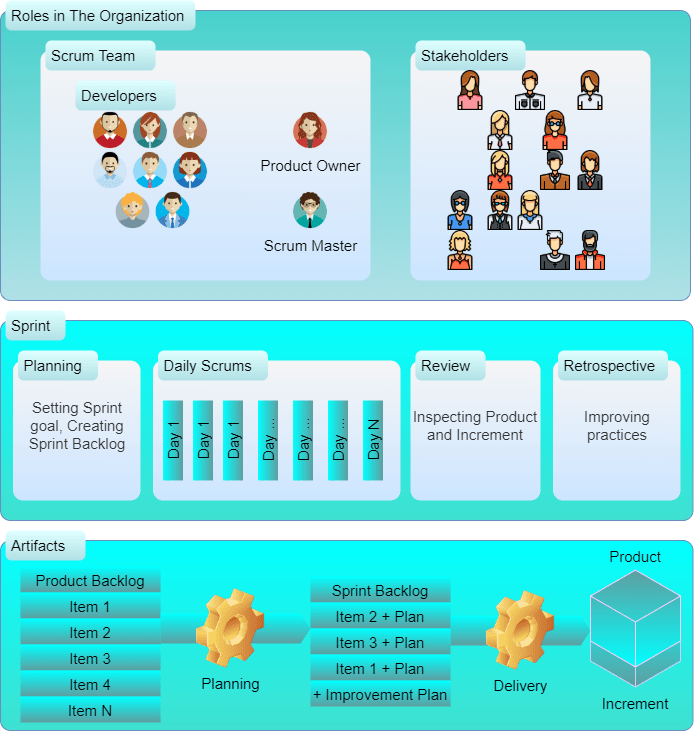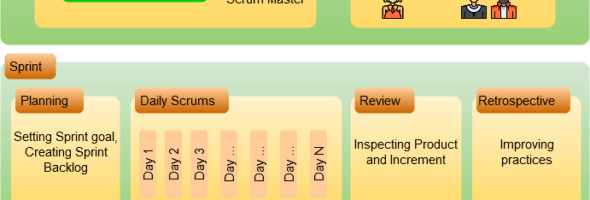Scrum’s definition consists of Scrum’s roles, events, artifacts, and the rules that bind them together. (Paraphrased from Ken Schwaber and Jeff Sutherland). The below interactive map describes these roles, events and artifacts
Scrum Interactive
For more information, click an entity!

Product Owner
"The Product Owner is accountable for maximizing the value of the product resulting from the work of the Scrum Team. How this is done may vary widely across organizations, Scrum Teams, and individuals."
Scrum Master
"The Scrum Master is accountable for establishing Scrum as defined in the Scrum Guide. They do this by helping everyone understand Scrum theory and practice, both within the Scrum Team and the organization."
Developers of the Scrum Team
"Developers are the people in the Scrum Team that are committed to creating any aspect of a usable Increment each Sprint.
The specific skills needed by the Developers are often broad and will vary with the domain of work."
Sprint
"Sprints are the heartbeat of Scrum, where ideas are turned into value.
They are fixed length events of one month or less to create consistency. A new Sprint starts immediately after the conclusion of the previous Sprint.
All the work necessary to achieve the Product Goal, including Sprint Planning, Daily Scrums, Sprint Review, and Sprint Retrospective, happen within Sprints."
Sprint Planning
"Sprint Planning initiates the Sprint by laying out the work to be performed for the Sprint. This resulting plan is created by the collaborative work of the entire Scrum Team. Sprint Planning addresses the following topics:
- Topic One: Why is this Sprint valuable?
- Topic Two: What can be Done this Sprint?
- Topic Three: How will the chosen work get done?"
Daily Scrum
"The purpose of the Daily Scrum is to inspect progress toward the Sprint Goal and adapt the Sprint Backlog as necessary, adjusting the upcoming planned work.
The Daily Scrum is a 15-minute event for the Developers of the Scrum Team. To reduce complexity, it is held at the same time and place every working day of the Sprint. If the Product Owner or Scrum Master are actively working on items in the Sprint Backlog, they participate as Developers."
Sprint Review
"The purpose of the Sprint Review is to inspect the outcome of the Sprint and determine future adaptations. The Scrum Team presents the results of their work to key stakeholders and progress toward the Product Goal is discussed."
Sprint Retrospective
"The purpose of the Sprint Retrospective is to plan ways to increase quality and effectiveness.
The Sprint Retrospective concludes the Sprint. It is timeboxed to a maximum of three hours for a one-month Sprint. For shorter Sprints, the event is usually shorter."
Product Backlog
"The Product Backlog is an emergent, ordered list of what is needed to improve the product. It is the single source of work undertaken by the Scrum Team.
Commitment: Product Goal
The Product Goal describes a future state of the product which can serve as a target for the Scrum Team to plan against. The Product Goal is in the Product Backlog. The rest of the Product Backlog emerges to define “what” will fulfill the Product Goal."
Sprint Backlog
"The Sprint Backlog is composed of the Sprint Goal (why), the set of Product Backlog items selected for the Sprint (what), as well as an actionable plan for delivering the Increment (how).
Commitment: Sprint Goal
The Sprint Goal is the single objective for the Sprint."
Increment
"An Increment is a concrete stepping stone toward the Product Goal. Each Increment is additive to all prior Increments and thoroughly verified, ensuring that all Increments work together. In order to provide value, the Increment must be usable."
Stakeholders - Not a role in Scrum
Stakeholders do not have a role in Scrum, however, they play an important role in running the organization, planning, implementing and using the product, etc.
The Scrum Team
"The fundamental unit of Scrum is a small team of people, a Scrum Team. The Scrum Team consists of one Scrum Master, one Product Owner, and Developers. Within a Scrum Team, there are no sub-teams or hierarchies. It is a cohesive unit of professionals focused on one objective at a time, the Product Goal."
Scrum in a Nutshell
The latest authentic Scrum Guide from Ken Schwaber and Jeff Sutherland is already a short read. This page, however, is a good overview of the guide before we decide to dive into the details. All text is quoted from the latest guide.
Scrum Theory
Transparency
The emergent process and work must be visible to those performing the work as well as those receiving the work.
Inspection
The Scrum artifacts and the progress toward agreed goals must be inspected frequently and diligently to detect potentially undesirable variances or problems.
Adaptation
If any aspects of a process deviate outside acceptable limits or if the resulting product is unacceptable, the process being applied or the materials being produced must be adjusted.
Scrum Values
Successful use of Scrum depends on people becoming more proficient in living five values:
Commitment, Focus, Openness, Respect, and Courage
Scrum Team
The fundamental unit of Scrum is a small team of people, a Scrum Team. The Scrum Team consists of one Scrum Master, one Product Owner, and Developers. Within a Scrum Team, there are no sub-teams or hierarchies. It is a cohesive unit of professionals focused on one objective at a time, the Product Goal.
Developers
Developers are the people in the Scrum Team who are committed to creating any aspect of a usable Increment each Sprint. The specific skills needed by the Developers are often broad and will vary with the domain of work.
Product Owner
The Product Owner is accountable for maximizing the value of the product resulting from the work of the Scrum Team. How this is done may vary widely across organizations, Scrum Teams, and individuals.
Scrum Master
The Scrum Master is accountable for establishing Scrum as defined in the Scrum Guide. They do this by helping everyone understand Scrum theory and practice, both within the Scrum Team and the organization.
The Scrum Master is accountable for the Scrum Team’s effectiveness. They do this by enabling the Scrum Team to improve its practices, within the Scrum framework.
Scrum Masters are true leaders who serve the Scrum Team and the larger organization.
Scrum Events
The Sprint is a container for all other events. Each event in Scrum is a formal opportunity to inspect and adapt Scrum artifacts. These events are specifically designed to enable the transparency required. Failure to operate any events as prescribed results in lost opportunities to inspect and adapt. Events are used in Scrum to create regularity and to minimize the need for meetings not defined in Scrum.

The Sprint
Sprints are the heartbeat of Scrum, where ideas are turned into value.
They are fixed-length events of one month or less to create consistency. A new Sprint starts immediately after the conclusion of the previous Sprint.
All the work necessary to achieve the Product Goal, including Sprint Planning, Daily Scrums, Sprint Review, and Sprint Retrospective, happen within Sprints.
Sprint Planning
Sprint Planning initiates the Sprint by laying out the work to be performed for the Sprint. This resulting plan is created by the collaborative work of the entire Scrum Team. Sprint Planning addresses the following topics:
Topic One: Why is this Sprint valuable?
Topic Three: How will the chosen work get done?
Topic Two: What can be Done in this Sprint?
Daily Scrum
The purpose of the Daily Scrum is to inspect progress toward the Sprint Goal and adapt the Sprint Backlog as necessary, adjusting the upcoming planned work.
The Daily Scrum is a 15-minute event for the Developers of the Scrum Team. To reduce complexity, it is held at the same time and place every working day of the Sprint. If the Product Owner or Scrum Master are actively working on items in the Sprint Backlog, they participate as Developers.

Sprint Review
The purpose of the Sprint Review is to inspect the outcome of the Sprint and determine future adaptations. The Scrum Team presents the results of their work to key stakeholders and progress toward the Product Goal is discussed.
Sprint Retrospective
The purpose of the Sprint Retrospective is to plan ways to increase quality and effectiveness.
The Sprint Retrospective concludes the Sprint. It is timeboxed to a maximum of three hours for a one-month Sprint. For shorter Sprints, the event is usually shorter.
Scrum Artifacts
Scrum’s artifacts represent work or value. They are designed to maximize the transparency of key information. Thus, everyone inspecting them has the same basis for adaptation.
Product Backlog
The Product Backlog is an emergent, ordered list of what is needed to improve the product. It is the single source of work undertaken by the Scrum Team.
Commitment: Product Goal
The Product Goal describes the future state of the product which can serve as a target for the Scrum Team to plan against. The Product Goal is in the Product Backlog. The rest of the Product Backlog emerges to define “what” will fulfil the Product Goal.
Sprint Backlog
The Sprint Backlog is composed of the Sprint Goal (why), the set of Product Backlog items selected for the Sprint (what), as well as an actionable plan for delivering the Increment (how).
Commitment: Sprint Goal
The Sprint Goal is the single objective for the Sprint.
Increment
An Increment is a concrete stepping stone toward the Product Goal. Each Increment is additive to all prior Increments and thoroughly verified, ensuring that all Increments work together. In order to provide value, the Increment must be usable.
Commitment: Definition of Done
The Definition of Done is a formal description of the state of the Increment when it meets the quality measures required for the product.

